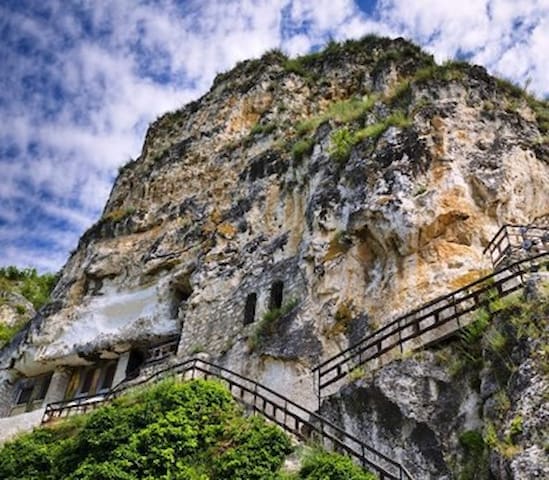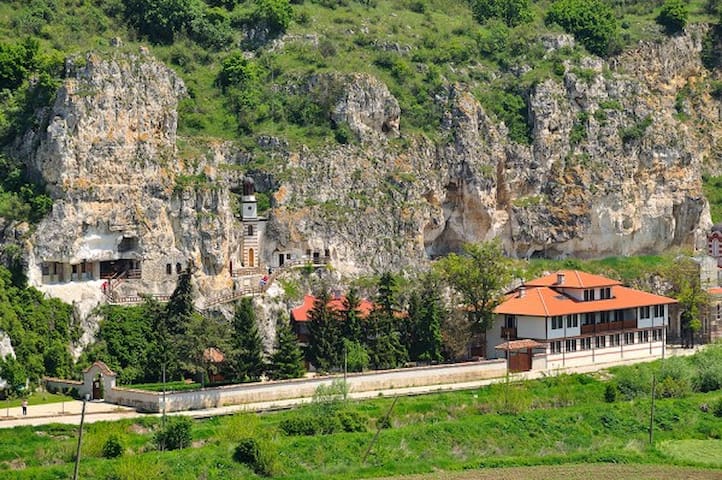Разглеждане на забележителности
Cherven is a medieval Bulgarian town, one of the most important military, cultural and ecclesiastical centers of the Second Bulgarian State (12-14 century).
It is located near the village of Cherven, 34 km south of Ruse. There are several hypotheses about the origin of the name Red. The most common of these is that the name is derived from the adjective "red". According to another, the name was given by Russian settlers who left their eponymous city in Galicia after the Tatar invasion in the 13th century.
There was an early Byzantine fortress in Cherven from the 6th century. After 1018, when Bulgaria was finally included in the boundaries of the Byzantine Empire, the early Byzantine fortifications on the Red Hill attracted the attention of the new rulers. The surviving fortress walls have been repaired and complied with their fortification requirements. In the history of Cherven during the Second Bulgarian Kingdom there was both a rise and a decline. In 1230 there was a strong earthquake, which caused damage throughout Eastern Europe, and in Cherven caused a fire and large-scale destruction. In 1235 the town became the seat of the Medieval Bulgarian Red Diocese. It is known that in the spring of 1242 part of the retreating Tatar army moved along the valley of the river Rusenski Lom, leaving behind a general destruction. Also in the 13th century (according to Manuel Phil), the Byzantine military leader Michael the Great Tarkhaniot conquered the city in a campaign against Tsar Ivailo.
In the 14th century the territory of the town exceeded 1.8 km², with a well-defined infrastructure, including a fortified town, situated on a vast rocky hill along the river Cherni Lom. A number of crafts have been developed: mining and processing of iron, goldsmithing, construction, arts, household and other crafts, which makes it an important commercial center. At the end of the 14th century, together with the rest of the Bulgarian lands, it fell under Ottoman rule and was devastated. Legends and some historical sources indicate that many of the inhabitants of the large and prosperous city in the Middle Ages migrated to the settlement, known in Roman times as Sexaginta Prista, during the Ottoman rule - Ruschuk, and today - the city of Ruse.
Pháo đài Cherven
24 Хан ИсперихCherven is a medieval Bulgarian town, one of the most important military, cultural and ecclesiastical centers of the Second Bulgarian State (12-14 century).
It is located near the village of Cherven, 34 km south of Ruse. There are several hypotheses about the origin of the name Red. The most common of these is that the name is derived from the adjective "red". According to another, the name was given by Russian settlers who left their eponymous city in Galicia after the Tatar invasion in the 13th century.
There was an early Byzantine fortress in Cherven from the 6th century. After 1018, when Bulgaria was finally included in the boundaries of the Byzantine Empire, the early Byzantine fortifications on the Red Hill attracted the attention of the new rulers. The surviving fortress walls have been repaired and complied with their fortification requirements. In the history of Cherven during the Second Bulgarian Kingdom there was both a rise and a decline. In 1230 there was a strong earthquake, which caused damage throughout Eastern Europe, and in Cherven caused a fire and large-scale destruction. In 1235 the town became the seat of the Medieval Bulgarian Red Diocese. It is known that in the spring of 1242 part of the retreating Tatar army moved along the valley of the river Rusenski Lom, leaving behind a general destruction. Also in the 13th century (according to Manuel Phil), the Byzantine military leader Michael the Great Tarkhaniot conquered the city in a campaign against Tsar Ivailo.
In the 14th century the territory of the town exceeded 1.8 km², with a well-defined infrastructure, including a fortified town, situated on a vast rocky hill along the river Cherni Lom. A number of crafts have been developed: mining and processing of iron, goldsmithing, construction, arts, household and other crafts, which makes it an important commercial center. At the end of the 14th century, together with the rest of the Bulgarian lands, it fell under Ottoman rule and was devastated. Legends and some historical sources indicate that many of the inhabitants of the large and prosperous city in the Middle Ages migrated to the settlement, known in Roman times as Sexaginta Prista, during the Ottoman rule - Ruschuk, and today - the city of Ruse.
It is located on the right slope of the valley of the river Cherni Lom, 6 km east of Dve Mogili and 2.5 km east of the village of Pepelina, the village of Shirokovo, the village of Ostritsa, 45 km from the town of Ruse. The entrance of the cave is at a height of 40 m above the river level, down to the entrance of the cave leads a steep path with stairs. From the entrance there is a view of the nature park "Rusenski Lom" and the beautiful rock landmarks around.
Hang động Orlova Chuka
40 ул. „Йордан Йовков“It is located on the right slope of the valley of the river Cherni Lom, 6 km east of Dve Mogili and 2.5 km east of the village of Pepelina, the village of Shirokovo, the village of Ostritsa, 45 km from the town of Ruse. The entrance of the cave is at a height of 40 m above the river level, down to the entrance of the cave leads a steep path with stairs. From the entrance there is a view of the nature park "Rusenski Lom" and the beautiful rock landmarks around.
They have distinctively preserved frescoes compared to other complexes in Bulgaria. Unlike the traditional monasteries, consisting of 1-2 churches, monastic and economic part, in Ivanovo there is a variety of small rock churches, chapels and cells carved at different heights in the rocks of the picturesque canyon of the river Rusenski Lom.
The churches near Ivanovo are part of the hundreds of medieval rock churches, monasteries, hermitages and separate hermitage cells, which in the period X-XIV century turned the river valley and its tributaries into a Bulgarian spiritual center.
Nhà thờ đá của Ivanovo
They have distinctively preserved frescoes compared to other complexes in Bulgaria. Unlike the traditional monasteries, consisting of 1-2 churches, monastic and economic part, in Ivanovo there is a variety of small rock churches, chapels and cells carved at different heights in the rocks of the picturesque canyon of the river Rusenski Lom.
The churches near Ivanovo are part of the hundreds of medieval rock churches, monasteries, hermitages and separate hermitage cells, which in the period X-XIV century turned the river valley and its tributaries into a Bulgarian spiritual center.
The monastery dates back to the period of the Second Bulgarian Kingdom (XII-XIV century), but the earliest data date from the Ottoman tax registers from 1431. There it is marked as "Bessarabia" - a property with 14 households. At the same time, the monastery is marked as "timar of the great voivode" - meaning Ivanko Besarab - father-in-law of Tsar Ivan Alexander. According to another legend, the Basarbovo monastery was dedicated to St. Theodore Tyrone and St. Theodore Stratilat. The founder of the monastery was Queen Theodora Basarab - the first wife of Tsar Ivan Alexander and daughter of the Wallachian voivode Ivanko Basarab. The nearby village of Basarabovo is also named after the voivode. The most famous inhabitant and eternal abbot is Saint Dimitar Basarbovski, born in 1685 and spent his whole life in the monastery. Paisii Hilendarski also mentions this holy monastery in his "Slavo-Bulgarian History". During the Russo-Turkish War (1768 - 1774) the relics of the saint were transferred by Gen. Ivan P. Saltikov in Bucharest and placed in the Metropolitan, and today the Patriarchal Church "St. St. Constantine and Helena" on July 13, 1774, where they are to this day. In 1937 the monk Chrysanthemum settled in the monastery and began to renovate it.
The temple holiday of the monastery is on October 26, the day of St. Dimitar.
Basarbovo Monastery
The monastery dates back to the period of the Second Bulgarian Kingdom (XII-XIV century), but the earliest data date from the Ottoman tax registers from 1431. There it is marked as "Bessarabia" - a property with 14 households. At the same time, the monastery is marked as "timar of the great voivode" - meaning Ivanko Besarab - father-in-law of Tsar Ivan Alexander. According to another legend, the Basarbovo monastery was dedicated to St. Theodore Tyrone and St. Theodore Stratilat. The founder of the monastery was Queen Theodora Basarab - the first wife of Tsar Ivan Alexander and daughter of the Wallachian voivode Ivanko Basarab. The nearby village of Basarabovo is also named after the voivode. The most famous inhabitant and eternal abbot is Saint Dimitar Basarbovski, born in 1685 and spent his whole life in the monastery. Paisii Hilendarski also mentions this holy monastery in his "Slavo-Bulgarian History". During the Russo-Turkish War (1768 - 1774) the relics of the saint were transferred by Gen. Ivan P. Saltikov in Bucharest and placed in the Metropolitan, and today the Patriarchal Church "St. St. Constantine and Helena" on July 13, 1774, where they are to this day. In 1937 the monk Chrysanthemum settled in the monastery and began to renovate it.
The temple holiday of the monastery is on October 26, the day of St. Dimitar.




